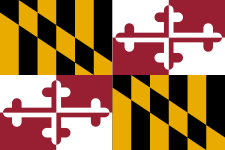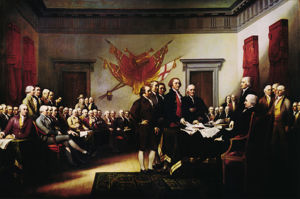| Preceded by 2nd Governor Thomas Sim Lee |
William Paca 3rd Governor of Maryland1782—1785 |
Succeeded by 4th Governor William Smallwood |
| William Paca Esq participated in the American Revolution. Join: 1776 Project Discuss: 1776 |
Biography
- St. John's Parish Register Log, "William Paca son of the above mentioned persons (John Paca & Elizabeth Smith) was born October 31st 1740." [1] on his father's plantation on the Bush River near Abingdon in Baltimore County, Maryland (now Harford County).
He was the third child and second son of John Paca (c1712-1785), planter, and his wife Elizabeth Smith (d: c1766). Both of his parents were natives of Maryland and of English descent. In addition to his older brother Aquila, Paca had five sisters.
William, at age eleven, and Aquila were sent to the Philadelphia Academy and Charity School in 1752. Beginning in 1756, William Paca continued his education at the College of Philadelphia, from which he received a B.A. degree in May 1759. Three years later he collected an M.A. degree, available upon request to graduates in good standing without requirement of further study. In the late spring or early summer of 1759 Paca took up residence in Annapolis, capital of Maryland, where he studied law with Stephen Bordley, one of the preeminent lawyers of the day. Records of the Inner Temple (where Bordley had also studied) indicate that Paca was admitted as a member of the commons, but the timing and duration of his stay in London remain unclear.
William Paca began his legal career in 1761, qualifying as an attorney in both several county courts and the more prestigious provincial courts. In addition to a successful law practice, he solidified his position among the Maryland gentry by his marriage on 26 May 1763 to heiress Mary Chew, daughter of Samuel Chew (c1704-1737) and his wife Henrietta Maria Lloyd (d: 1765).
- The couple had three children, of whom only John Philemon Paca (1771-1840) survived to adulthood, before Mary's death in Jan 1774.
- During the 1760s Paca also took an active role in the political life of Maryland. With fellow attorney Samuel Chase, he was one of the leaders of the Annapolis protests in 1765 against the Stamp Act and an organizer of the Anne Arundel chapter of the Sons of Liberty. In May 1766 Paca was elected as a common councilman for the City of Annapolis and the following year local voters chose him as one of their representatives in the House of Delegates. He remained a representative for Annapolis through the final provincial assembly of 1774.
Paca continued to play an active political role as protests against proprietary actions evolved into protests against British rule. Both in court and in print, Paca argued against the proprietary position on determination of officials' fees and against the clergy's position on the poll tax levied for their support -- despite being himself a member of the vestry. As Maryland moved toward independence, Paca represented Annapolis in the extra-legal conventions that ruled the province beginning in 1774, and was chosen as one of Maryland's delegates to the first continental congress. Paca served longer as a delegate than any other Marylander, and was one of the two who both voted for and signed the Declaration of Independence. He also served in the Maryland Senate from 1777 until his resignation in 1780. Paca held no military commission during the revolutionary war, but did serve as one of three commissioners responsible for organizing the defense of the Eastern Shore
While in Philadelphia as a delegate, on 28 Feb 1777 in Christ Church Paca married Anne Harrison (1757-1780), daughter of Henry Harrison (c1713-1766), merchant and former mayor, and his wife, Mary Aspden. The couple had one child before Anne's death in Feb 18, 1780; their son Henry died in 1781. In the interval between the death of Mary Paca and his marriage to Anne Harrison, Paca fathered two children, by two different women, of whom Henrietta Maria (c1777-1850), daughter of Sarah Joice of Annapolis, survived him.
William Paca resigned as a delegate to congress when appointed a judge of the Court of Appeals for Admiralty and Prize Cases in 1780, and resigned that position when elected governor of Maryland in Nov 1782. Paca served three one-year terms as governor (the statutory limit) and was in office when Congress met in Annapolis in 1783-1784, where it ratified the Treaty of Paris on 15 Jan 1784. Following the expiration of his third term as governor, Paca was elected to both the Senate and House of Delegates; he chose to sit in the House as the body more responsive to the interests of the people.
Paca refused election to the Constitutional Convention in 1787, but did represent Harford County (a recently-created county that included his birthplace) as an anti-Federalist in the Ratification Convention held in April 1788. He proposed twenty-eight amendments to the Constitution designed to ensure personal freedoms and limitations on federal powers similar to safeguards written into the Maryland constitution. Although his efforts were thwarted by the Federalists who controlled the convention, a number of Paca's ideas were later incorporated in the Bill of Rights. Despite Paca's opposition to the new form of government, George Washington appointed him a judge for the federal district court of Maryland in Dec 1789, recognizing that without men like Paca, there would have been no American government, federal or otherwise.
William Paca built an elegant Georgian mansion with a two-acre pleasure garden in Annapolis immediately after his marriage to Mary Chew. He sold that house (which still stands) in 1780 and made his primary residence on Wye Island on Maryland's Eastern Shore (property inherited by Mary from her brother and held in trust for their son John), where he built an even more grand house, Wye Hall, in the 1790s.
He was a lawyer, politician, 3rd Governor of Maryland and a signer of the American Declaration of Independence.
He died on 23 Oct 1799 at Wye Hall on Wye Island in Queen Anne's County, Maryland, USA and was most likely buried on the grounds, although the location of his grave is unknown.
- Memorial Stone photo on f-a-g
- Wye Plantation, Queen Anne's County, Maryland
- WikiTree+ Suggestions Help [view on WikiTree+]
- Warning Wikidata - Possible father Help → WikiData: Q96184171
- Q766814
- I answered it "He has a father?" fixed
Sources
- ↑ familysearch.org St,John's Parish Register Log page 148 Accessed Oct 22 2020 image attached<
See also:
- Biograpghy at Maryland State Archives]
- Wikipedia for William Paca
- Find A Grave: Memorial #2811 created by FindAGrave/ photo of Memorial stone
- Maryland.gov BIO/ Photo page 1 - page 25 His time doing service, letters from him and to him, and a sketch of Wye Hall
Acknowledgements
Paca-5 was created by Ken Broughton on 30 May 2014.
It may be possible to confirm family relationships with William by comparing test results with other carriers of his Y-chromosome or his mother's mitochondrial DNA. However, there are no known yDNA or mtDNA test-takers in his direct paternal or maternal line. It is likely that these autosomal DNA test-takers will share some percentage of DNA with William:
-
~0.78%
Michael Breed
 :
AncestryDNA
:
AncestryDNA
Have you taken a DNA test? If so, login to add it. If not, see our friends at Ancestry DNA.
Featured Foodie Connections: William is 19 degrees from Emeril Lagasse, 19 degrees from Nigella Lawson, 21 degrees from Maggie Beer, 41 degrees from Mary Hunnings, 28 degrees from Joop Braakhekke, 22 degrees from Michael Chow, 19 degrees from Ree Drummond, 22 degrees from Paul Hollywood, 23 degrees from Matty Matheson, 22 degrees from Martha Stewart, 29 degrees from Danny Trejo and 26 degrees from Molly Yeh on our single family tree. Login to find your connection.
Categories: American Founding Fathers | Society of the Cincinnati | Maryland Governors | Baltimore County, Province of Maryland | Maryland, American Revolution | Continental Congress | Signers of the Continental Association | Signers of the United States Declaration of Independence | Wye Plantation, Queen Anne's County, Maryland | NSDAR Patriot Ancestors | Notables









The son that lived to adulthood Paca-32 Daughter Henrietta who died in infancy Paca-38 Son William Jr who died at 5 years old Paca-39 These are the 3 children William had with Mary Chew before she died. The only son to be born to Ann is Paca-37, who died before he was 1 year and months after his mother.
edited by Carole Taylor
f-a-g has this for his "Mistresses, whom he had children with." should his mistresses be listed as wife? and Married????? His first wife, Mary Chew, died at age 38, and only one of their three children lived to adulthood. He remarried, to Anne Harrison, who died at age 23, and their only child died at age 2.
Paca would have two other children; to women he did not marry. One of them was his daughter, Hester, whose mother was a free black woman, creating somewhat of a scandal at the time. He would raise Hester and send her to the finest boarding school in Philadelphia. I did not see the story of Henrietta Maria who lived to be married........
edited by Carole Taylor
John Philemon, William, Henry, Henrietta Maria, (listed twice?) Hester" They have knowledge of 2 wives yet we have 4? wikipedia only mentions his 1st wife/ their 3 kids....
edited by Carole Taylor
Post a comment on the PPP profile that includes the WikiTree ID of the profile that should be connected.